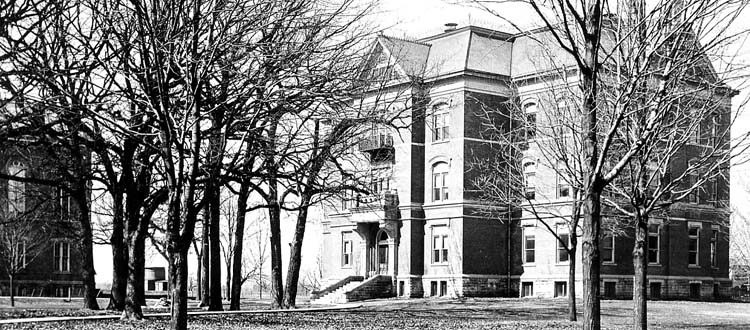Serene
on the University of Iowa’s Pentacrest facing North Hall (left edge),
soon after the image was recorded, Calvin Hall was picked up and rolled
across
Jefferson Street in 1905. Note a tiny observatory building between the tree
trunks.
A Hibbs Collection image.
|
By
Bob Hibbs
Moving
a 12-million-pound building a few inches, let along 150 feet across a street,
is intuitively impossible.
Yet,
that feat was accomplished a century ago in Iowa City – and, the plaster
wasn’t even cracked – or so the story goes!
Despite
intuition, history records that such an event took place during the summer of
1905.
Worse,
we’re told classes were taught in the building while it was moving. Oh,
forget intuition!
The
above correctly describes a historic move of all 6,000 tons of Calvin Hall
from the University of Iowa’s Pentacrest Campus across Jefferson Street to
its present location. It was done to make way for construction of Macbride
Hall.
The
mystery of this endeavor ranks with such engineering marvels as the work of
our ancient American ancestors in building Saqsaywamán, Machu Picchu, Tikal,
the Great Pyramid at Teotihuacán or Cahokia Monks Mound near St. Louis. The
work must have been done by wayfarers from outer space or locals trained by
them.
Oh,
nonsense!
They
jacked it up, put it on logs and rolled it to its new site, just as the
ancients rolled stones into place. It’s a mystery only in the eyes of the
beholder. Fantastic, yes; mysterious, no!
So,
when late 18th century planning prepared under the guidance of UI’s
distinguished eighth president, Charles Schaeffer, produced four large
limestone companions for Old Capitol clothed in its classic architectural
style, the days became numbered for six existing red brick structures which
flanked Old Cap.
A
55-year-old Schaeffer died of an apparent heart attack in 1898 just as
construction was being initiated on the great hall which now bears his name.
But, the plan he championed and sold survived. A state-wide property tax he
sold to legislators and the governor paid for many UI buildings during the
subsequent decade.
His
Pentacrest plan was furthered by a 1901 fire which destroyed two of the six
“reds” just as Schaeffer Hall was nearing completion. The loss of
five-level 1882 Medical Building and four-level 1862 South Hall adjacent to
Old Cap helped galvanize support which resulted in a spurt of construction at
the university.
The
med school received the first of its new quarters in 1904 with opening of what
now is a biological sciences library in the middle of the block behind (east
of) present-day Phillips Hall. The engineering college got new quarters in
1905 with the first phase of its present building along West Washington
Street.
Moving
Calvin Hall across Jefferson Street ushered in the next stage in development
on Pentacrest.
It
was accomplished by Chicago-based Freistedt Co. which shipped in 800
hand-screw jacks along with 27 railroad car loads of timbers and 675
six-inch-diameter rollers, each four feet long.
After
the move, Macbride Hall was built for 1908 occupancy, then MacLean Hall in
1912 and Jessup Hall in 1924.
Meanwhile,
1866 North Hall and 1895 Old Dental saw use for another half century before
demolition provided a finished Pentacrest fully reflecting the visionary
planning from the Schaeffer years.
P.S.
Long-time friend Johanna Beers died Tuesday. She’s remembered here for her
warmth and effervescent friendliness. She always had time to listen, offer
counsel or a smile with a word of reassurance.
Our
42-year-old career Air Force son, Randy, as a toddler during the late 1960s
would burst past my desk in the Press-Citizen newsroom to see “Aunt Jo”
for he knew she had candy in the bottom left desk drawer.
She
never failed him; just as she never failed her readers during 67 years of
writing for the paper.
She
championed the Chicago Cubs to Randy, who now carries her torch for them in
this family.
It
was a blessing to know her; her death is a real loss; but, there are many
memories to cherish.
Next
Saturday: Lone Tree’s Historic
Heritage. Bob Hibbs collects local postcards and other historic ephemera and researches history related to them. |
